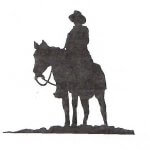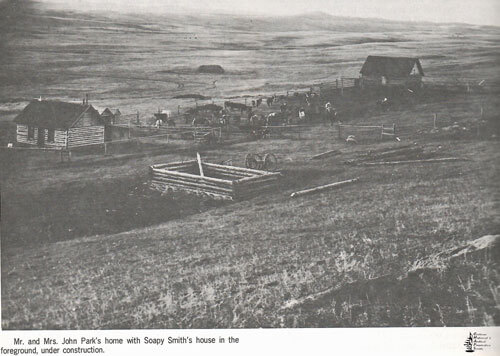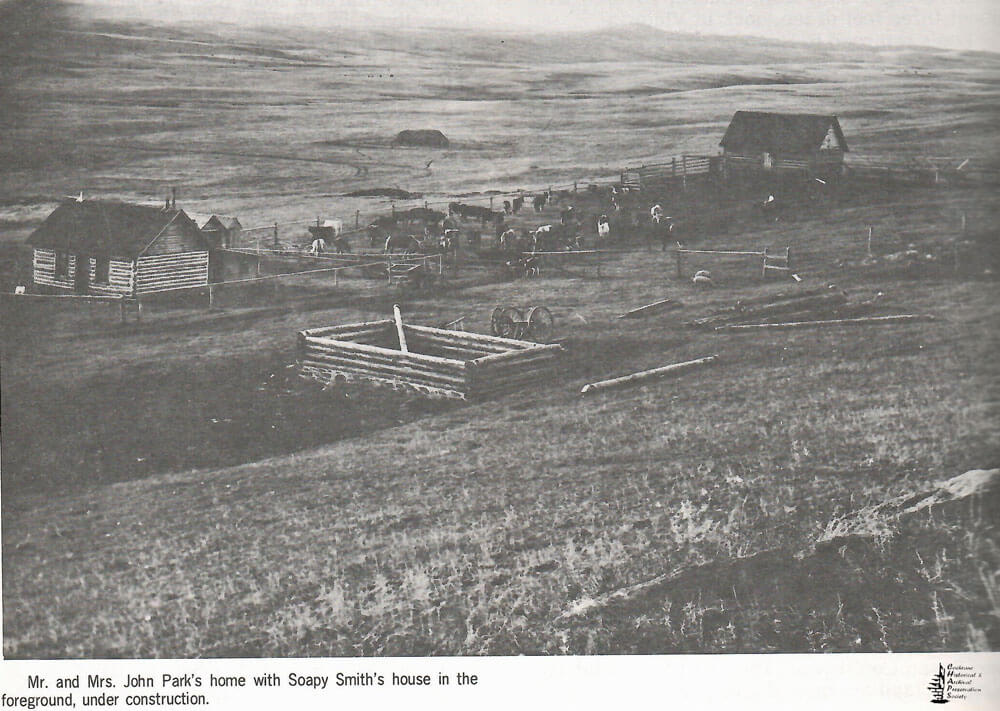– by Bessie MacEwan pg 774 Big Hill Country, 1977
In 1898 my father and mother, Mr. and Mrs. John Park, came to Canada, to Calgary and on to Cochrane. With them came my brother Andrew, aged three and a half. My sister Peggie and I remained at school in Scotland for seven years.
Mother and Father, and of course Andrew, stayed at the Queen’s Hotel in Calgary for six weeks. Calgary then consisted of Eighth Avenue (Stephen Ave.), it being from Second Street East to First Street West, with wooden sidewalks and mud.
Father had come to Canada after his business in Scotland went into liquidation because he and “Johnny Walker” were much too friendly. No, he was not a remittance man but did have a bi-yearly allowance from his father’s estate. He could have had a homestead within the (then) City of Calgary limits but as “Johnny Walker” seemed to have relations here, he preferred to go further west. They proceeded to the XC Ranch and I believe were there two or three years. Finally, Father took up a homestead on NW14 16 25-5-5; later he bought two other quarters, one homesteaded by Herb (Soapy) Smith, and the other by Uncle Bob, who came to Canada in 1903. Soapy Smith was a guide in the mountains and only lived on his place part of the time. My father bought another half section of land in the same area later. The fourth quarter of sixteen was reserved by the Government for water reserve. My father’s brand was Bar reversed LR.
Father built a log house on his quarter; it was lined with fir and in one of Mother’s letters we read incorrectly and thought it was lined with fur. When we were prepared to come out, we had with us a huge packing case of the very warmest clothing, for which we never had a use. We cut and braided them for the beautiful rugs my mother fashioned. Father still hob-nobbed with “Johnny’s” relations but Mother was a wonderful woman. While they were at the XC, Clem Gardner, then a boy, and his two sisters used to all get on one horse and jump over barrels, hence Clem’s great horsemanship.
For months on end, Mother never saw a white woman. The Indians [sic] came, and Mother fed them; always they wrapped up the food they couldn’t consume and said, “Squaw [sic], papoose.”
Water was carried from the spring and woodcut in the bush and chopped for firewood. Mother made furniture from apple and orange boxes or whatever was around; made drapes from bleached flour sacks and embroidered them. Later she advanced in her carpenter work and made the most beautiful and durable furniture from lumber, painted it with a green heart stain, and varnished it. She made a buffet, china cabinet and even a table with extension leaves. Mother also made upholstered chairs from apple barrels. The windows were draped with embroidered flour sacks. There were lots of flour sacks around because Mother did all her own baking, including bread.
My brother had no little playmates but he did have his little dog, “Curly.” She pulled his sleigh in winter and a play hayrack with his favourite rag doll in summer. When he later went to school, he had to ride nine miles, regardless of the weather, and Curly used to meet him one mile from home at the exact time of his return.
My sister and I came to Canada in 1906. The ocean trip onboard the Corinthian was exciting to us because it took fourteen days. We ran into icebergs and fog and the Captain lost control of the ship; for three days we were on our homeward journey, as the ship had about turned. We ran out of food, were given ship’s biscuits, life jackets, and we were shut off the decks. Upon arriving at Quebec, we were free to go ashore for the day as the ship had to have repairs. There were billboards telling of the loss of the Corinthian, with so many lives lost.
We arrived in Calgary, May 23, 1906, where Mother and Father met us. They boarded the train and travelled to Cochrane with us and that was to be our first shock. What a transformation! We had made our home in Scotland with our grandmother Park in all luxury. We had to stay overnight at the Murphy Hotel. The next day the ground was white with snow, a great experience to us. We drove to Joe Clemens’ ranch for lunch. He was a bachelor and had tin plates and enamelled mugs, more fun to us. Finally, we arrived at the little log house which was to be our home for a few years. It was a picture, I would say a “dream house” from a storybook and so sweet and spotless. Father and Mother had almost been burned out by a prairie fire on May 4th.
We could ride horseback, having had our own stables and ponies in Scotland. Then came the fun of learning to milk. Mother used to read from the “Home Preacher” (which I now possess) because there was no way of going to church other than driving to Cochrane 14 miles.
The roundup used to be held on the water reserve of section 16. My brother and I used to ride the range, too, in search of our lost animals.
Frank Ricks’ ranch adjoined Father’s and Frank was a wonderful neighbour. He built a lovely house and a covered passage to a new hayloft. We had many wonderful dances up there. The Masonic Ball and that of the Old Timers were the social events of the winter, held in Cochrane of course, and believe it or not there was a band with drums, otherwise, we danced to a mouth organ and fiddle. We really had a good time and arrived home usually in time for the a.m. milking, then off to bed until lunchtime. We always drove in a democrat as there were no cars. I remember the first car to come out there, and how the horses in the field stampeded and snorted when it was visible on a hill four or five miles away.
Of course, we all rode horseback, and at first, I used Mother’s sidesaddle, but one day Father weakened and brought home a lovely Australian saddle for me. Previously he had said it was unladylike for a girl to ride astride. I also rode a little racing saddle. I learned to break the odd horse and one day my brother dared me to break a cow to ride. The cow was a stray and simply wouldn’t stay away. She was unbranded and we named her Emily Jane. One day down at the water hole Andrew dared me to spring from my horse onto her back and that’s how it all started.
At one time we milked 31 cows by hand and I have milked all 31 by myself. We drove about 12 miles to Batemans with milk and cream. When we made butter in hot weather, I arose at four a.m. to get the churning done and butter made into pounds before the heat of the day. Yes, I also made bread, and Mr. Bateman sold it at his store. I was really making money. I think I realized about two dollars after making up 100 pounds of flour. I made bread for Stanley Cope and then I could really study Eaton’s Catalogue, known as the “Prairie Bible.” What fun! It was a very valuable book.
In winter we used to fill ticking with hay and put these under our mattresses because the wood stoves usually burned out by morning and the temperature in the a.m. was just about that of outdoors, sometimes 30 degrees below. We also put flat stones in the oven before going on any trip, then wrapped them in old blankets to keep our feet from freezing. We needed the warmth in spite of wearing felt boots and overshoes. The good old flat irons were heated at night and again wrapped in old pieces of a blanket to keep our beds warm during the cold nights.
Frank Sibbald was one of the first neighbours we were introduced to upon our arrival in Cochrane and what a wonderful person he was. He and Mrs. Sibbald and their three children became our dear friends, a friendship which has lasted these many years.
I was driving home from Cochrane alone one day and got caught in a blizzard. I thought I was driving along a wire fence and would soon come to the gate. After some time I decided to tie my team up and walk to the gate, only to find I had been driving around a haystack.
Willy Robb, later a bit of a horse thief, was around our country for a few years and I remember him arriving at our ranch one day with a horse that was fully grown. He had tried to make it into a hackney by cutting off its tail and it had become infected. I was to ride the horse but I didn’t take time to change into my divided skirt (which incidentally I had bought with my bread earnings) and my skirt worked its way over the horse’s sore tail. What a ride it was! Full speed uphill and down dale for miles and miles. The poor horse was more afraid than I was and however, we came home I just don’t know. I never did accept the invitation to ride it in the Cochrane Races.
I always wanted to become a nurse but my father objected, so one fine day when Andrew was going to Cochrane, I threw my saddle into the democrat, tied my horse behind, and off I went. I put my horse in the Cochrane stable and went to Calgary, made my arrangements and returned to Cochrane, then rode home. The fat was in the fire! My mind was made up and I went to the Columbia Hospital on, I think, Fourth Avenue West. It was a private hospital where all the elite went as patients. While there I had the honour of nursing the famous Bob Edwards and that was a barrel of fun. One evening Bob and his great friend went out and visited the “Holy Rollers” then returned to demonstrate to us what took place, Bob had a player piano in his office home in the old Commercial Block and we young hopefuls used to enjoy playing it. I went to the newly opened Typhoid Hospital on 16th Avenue North East.
The First World War broke out and my boyfriend, later my husband, went Overseas for what we thought would only be a short time. He was there four years. I went in training at the Calgary General Hospital and became the first Gold Medalist of the Calgary General. I was night supervisor for 16 months until I resigned to be married. My fiancé had then returned from the war and was discharge officer at Calgary Military District No. 13. We had two daughters Margaret (Peggie) Struthers MacEwan of Long Beach, California, and Vera Elizabeth, now Mrs. Luyendyk of Ottawa. Vera and her husband have two daughters, Karen and Jill. Karen has just entered University to take her B.Sc. in Nursing, thus carrying on a family tradition.
My sister Peggie only stayed on the ranch for about two years, went in training at the Royal Victoria Hospital in Montreal and then went Overseas with the McGill Unit. After three years of war service in No. 2 Canadian General Hospital, she married and had three children, a son Cyril, a daughter Ann and a second son who was killed in action in World War II.
My brother Andrew, now deceased, ranched around Vega, Alberta, having moved there about 40 years ago with his wife and six children, now all grown up, married and all over Canada.
I can remember when Andrew and I chopped blocks of snow and hauled piles of them to the house for Mother to melt as the spring was low. What a lot of snow it took for a washing!
Mother and Father moved to Cochrane and Mother’s lovely handmade furniture and rugs that had graced the ranch home were taken to their little white house in town. It was there that my dear mother passed away on November 24, 1922, at age 51. I nursed my mother until the end. Father remarried. Later I also nursed him, as I did my stepmother until they too passed on.
There is a ridge out at the old ranch named Park Ridge from which one day I hope my grandchildren may see oil flowing. Alberta’s Centennial film “West to the Mountains” was filmed on the Park Ridge. The opening scenes and the closing scenes with Burl Ives singing the title song, West to the Mountains, show this very beautiful country where we lived with our wonderful neighbours, the Sibbalds, Copithornes, Watts, Robinsons and many more.
Mr. and Mrs. Frank Brooks later purchased the Park’s house in Cochrane. It is now owned by Edgar Pears.
More reading





I found this article so interesting. It reminded me of some of my Mother and Dad’s experiences on their homestead. Their experiences didn’t begin
until 1927 on a homestead in the area north and west about 20 miles from
St. Paul, Alberta.
Mona (Sloan) Sylvestre
I found this article so interesting. It reminded me of some of my Mother and Dad’s experiences on their homestead. Their experiences didn’t begin
until 1927 on a homestead in the area north and west about 20 miles from
St. Paul, Alberta.
Mona (Sloan) Sylvestre